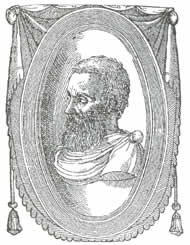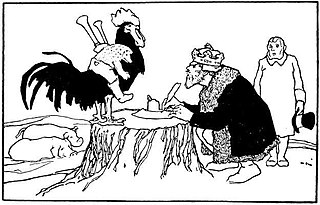Maestro Lattantio and His Apprentice Dionigi is an Italian literary fairy tale written by Giovanni Francesco Straparola in The Facetious Nights of Straparola . [1]
This tale plays off a long tradition of conflict between apprentices and their masters; a common oral folktale is such a conflict, where the master is instructing in either magic or theft. One such oral variant is The Thief and His Master . [2]
In Sicily, in the town of Messina, Maestro Lattantio had learned to be both a magician and a tailor. He took an apprentice, Dionigi, to teach to be a tailor, but Dionigi spied on him and lost all interest in being a tailor because of his desire to learn magic. Lattantio sent him away, but his father sent him back, where Lattantio often punished him for his laziness, but Dionigi bore it because he could watch Lattantio secretly and learn his magic. One day, his father found him doing housework rather than learning to be a tailor, and brought him home, grieved that after his money was spent, his son had not learned a trade.
Dionigi turned himself into a horse, and had his father display him for sale. Lattantio saw it and realized that it was Dionigi. He changed himself into a merchant and bought the horse. The father would not sell the bridle, but Lattantio increased his price until the father agreed. Lattantio then took the horse home and mistreated it. His two daughters pitied the horse and were kind to it. One day, they took it down to the stream to drink, where it dashed into the water and became a little fish. Lattantio, finding the horse gone, got his daughters to tell him what had happened, and turned himself into a tunny to chase Dionigi. Dionigi swam near the shore, and jumped into a basket carried by a handmaiden of the king's daughter, turning himself into a ruby ring. Violante, the king's daughter, found the ring and put it on. At night, when she went to bed, he changed into his own form, prevented her from screaming, and explained his plight; she promised to help him as long as he respected her honor. She kept him as a ring by day, and at night would talk with him in human form.
The king fell ill. Lattantio came and cured him, asking the princess's ring as his reward. The king summoned Violante, with orders to bring all her jewels, but Violante left behind the ring. Lattantio realized it was missing and said she could find it. She returned to her room and wept over the ring. Dionigi told her that the man was his enemy, and that she should bring the ring and when giving it, throw it against the wall as if in a temper. When she was finally compelled to bring the ring, she did as he had asked, and the ring became a pomegranate that, when it hit the floor, scattered seeds. Lattantio became a rooster and ate the seeds to put an end to Dionigi, but one seed hid out of his reach, and when it had a chance, turned to a fox and bit off the rooster's head. Dionigi told the king the story and with his consent married Violante.

Giovanni Francesco "Gianfrancesco" Straparola, also known as Zoan or Zuan Francesco Straparola da Caravaggio, was an Italian writer of poetry, and collector and writer of short stories. Some time during his life, he migrated from Caravaggio to Venice where he published a collection of stories in two volumes called The Facetious Nights or The Pleasant Nights. This collection includes some of the first known printed versions of fairy tales in Europe, as they are known today.

"The Sorcerer's Apprentice" is a poem by Johann Wolfgang von Goethe written in 1797. The poem is a ballad in 14 stanzas.

"Hans My Hedgehog" is a German fairy tale collected by the Brothers Grimm. The tale was translated as Jack My Hedgehog by Andrew Lang and published in The Green Fairy Book. It is of Aarne-Thompson type 441.

"The Master Thief" is a Norwegian fairy tale collected by Peter Chr. Asbjørnsen and Jørgen Moe. The Brothers Grimm included a shorter variant as tale 192 in their fairy tales. Andrew Lang included it in The Red Fairy Book. George Webbe Dasent included a translation of the tale in Popular Tales From the Norse.
Farmer Weathersky is a Norwegian fairy tale collected by Peter Chr. Asbjørnsen and Jørgen Moe in Norske Folkeeventyr.
"The Thief and His Master" is a German fairy tale collected by the Brothers Grimm in Grimm's Fairy Tales as tale number 68. In the first edition there was another fairy tale at place 68. The name of the fairy tale is "Von dem Sommer- und Wintergarten".

"Donkeyskin" is a French literary fairytale written in verse by Charles Perrault. It was first published in 1695 in a small volume and republished in 1697 in Perrault's Histoires ou contes du temps passé. Andrew Lang included it, somewhat euphemized, in The Grey Fairy Book. It is classed among folktales of Aarne-Thompson type 510B, unnatural love.
"The Silent Princess" is a Turkish fairy tale, structured as a frame story with three inserted tales: "The Magic Pomegranate" ; "The Carpenter, the Tailor, and the Clergyman"; "Three Suitors at the Graveyard". Andrew Lang included it in The Olive Fairy Book.
"The Pig King" or "King Pig" is an Italian literary fairy tale written by Giovanni Francesco Straparola in his The Facetious Nights of Straparola. Madame d'Aulnoy wrote a French, also literary, variant, titled Prince Marcassin.
"Master and Pupil" is a Danish fairy tale. Andrew Lang included it in The Pink Fairy Book.
King Kojata or The Unlooked for Prince or Prince Unexpected is a Slavonic fairy tale, of Polish origin. Louis Léger remarked that its source was "one of the most important collections of Polish literature".
"The Four Skillful Brothers" is a German fairy tale collected by the Brothers Grimm. It is Aarne-Thompson type 653.
Belle-Belle ou Le Chevalier Fortuné is a French literary fairy tale, written by Madame d'Aulnoy.
The Magic Book is a Danish fairy tale collected by Evald Tang Kristensen in Eventyr fra Jylland Andrew Lang included it in The Orange Fairy Book, listing it as translated by Mrs. Skavgaard-Pedersen.
Biancabella and the Snake is an Italian literary fairy tale written by Giovanni Francesco Straparola in The Facetious Nights of Straparola.
Guerrino and the Savage Man is an Italian literary fairy tale written by Giovanni Francesco Straparola in The Facetious Nights of Straparola.
Costanza / Costanzo is an Italian literary fairy tale written by Giovanni Francesco Straparola in The Facetious Nights of Straparola.
The Three Crowns is an Italian literary fairy tale written by Giambattista Basile in his 1634 work, the Pentamerone.

"Puss in Boots" is a European fairy tale about an anthropomorphic cat who uses trickery and deceit to gain power, wealth, and the hand in marriage of a princess for his penniless and low-born master.
The Story of Princess Zeineb and King Leopard is a French language fairy tale published in the 18th century. The tale belongs to the international cycle of the Animal as Bridegroom as a subtype, with few variants reported across Europe. In it, the heroine is delivered to a cursed or enchanted prince, but breaks a taboo and loses him; later, she finds work elsewhere and wards off the unwanted advances of male suitors with the magical object her enchanted husband gave her.